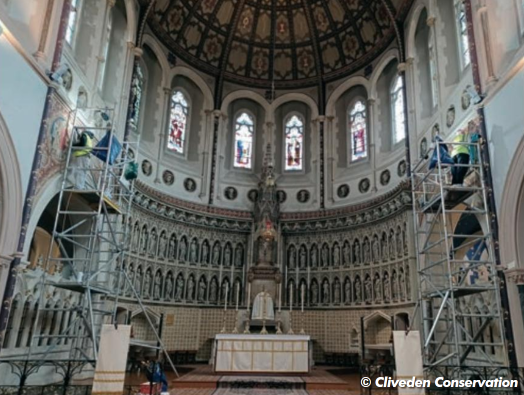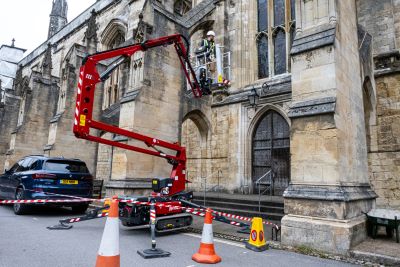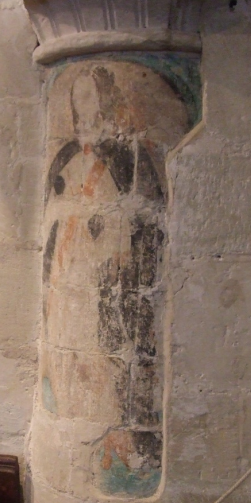Redecorating listed buildings and places of worship
 If you are thinking of redecorating the interior of your listed building or place of worship seek the advice of your architect or surveyor as implications of redecoration can be far reaching. There may well be technical aspects that need to be addressed before decoration can be carried out successfully. Redecoration can also have a major impact on the appearance of your building, including the way it looks and feels for worship.
If you are thinking of redecorating the interior of your listed building or place of worship seek the advice of your architect or surveyor as implications of redecoration can be far reaching. There may well be technical aspects that need to be addressed before decoration can be carried out successfully. Redecoration can also have a major impact on the appearance of your building, including the way it looks and feels for worship.
It is recognised that smaller parishes may not have the resources to use other than local labour, but beware DIY without advice! Church decorating is totally different from home decorating. Many expensive mistakes in churches are made with a paintbrush and your architect or surveyor should be consulted as to the correct type of paint and who could supply it. List B permission will be required for redecoration and a faculty may be required where material or colour is altered.
 The walls of the vast majority of churches have a degree of dampness in them due to one or more of the following causes:
The walls of the vast majority of churches have a degree of dampness in them due to one or more of the following causes:
- rain penetration;
- faulty rainwater goods;
- rising damp;
- condensation
This is to a certain extent unavoidable where:
- walls are solid;
- there is no damp-proof course;
- heating is intermittent;
- ventilation is inadequate;
- there are cement renders or pointing
It is essential, therefore, that when redecorating only those materials are used that can tolerate such conditions. It is a waste of money to apply paints that can only function properly and last well in a perfectly dry environment!
 As a first step, you will need to check that there is no water ingress caused by faulty gutters or downpipes, leaking roofs or valleys, or poor pointing which will spoil any new decoration. If there has been any water ingress for any length of time, it may be necessary to leave the walls to dry out before redecoration can be carried out.
As a first step, you will need to check that there is no water ingress caused by faulty gutters or downpipes, leaking roofs or valleys, or poor pointing which will spoil any new decoration. If there has been any water ingress for any length of time, it may be necessary to leave the walls to dry out before redecoration can be carried out.
Poor ventilation can lead to condensation (often at high level) which can cause black mildew growth and green algal growth on window panes. Leaving hopper vents generally open is advisable, but in damp weather conditions this could increase moisture levels within the church. Through-ventilation should also be maintained through suspended timber floor structures (e.g. pew platforms).
Royton Town Hall restoration uncovers hidden treasures as community welcomes transformation
In September, Royton Town Hall re-opened its doors following a complete restoration. The community has welcomed the transformation, which has included a new-look library, community space and a new garden area.
Bringing the much-loved landmark back to its original glory was at the heart of the project. The town hall's many Victorian features now have pride of place, including some which came as a brilliant surprise.
Click here for further information.

Painstaking effort reveals vibrancy of murals
During the 1950s the sanctuary of the Grade Two-listed Oratory Church of St Aloysius Gonzaga was reconfigured, the high altar was simplified and moved forward and all the polychrome decoration was over-painted. To restore its lost beauty, two large murals by Gabriel Pippet have now been uncovered. Polly Westlake, conservator at Cliveden Conservation, explains more about the project.Click here to read the full story.

Hinowa spider boom ‘vital’ for conserving ancient cathedral for future generations
A cathedral that dates back almost 1,000 years is being maintained in a condition that promises to see it thrive as a place of worship for centuries to come with the help of a Hinowa spider lift.
Expert teams dedicated to conserving Winchester Cathedral, in Hampshire, are using the Hinowa Lightlift 14.70 IIIS for multiple maintenance tasks inside and outside the ancient building.
Click here to read the full story.


I want to redecorate my historic house
External redecoration not only improves your house’s appearance but also protects it from the weather, while internal redecoration gives you the opportunity to make the most of original features within your historic home.
Click here to read the full story.

WALL PAINTINGS
 Churches of all ages, medieval, Georgian or Victorian may have decorated walls. This wall decoration (fresco, mural or stencil work), which is probably more widespread than is often thought, can be hidden by a number of layers of paint, and care may need to be taken if these layers of paint are to be stripped before redecoration occurs or if any plastering is found to be necessary.
Churches of all ages, medieval, Georgian or Victorian may have decorated walls. This wall decoration (fresco, mural or stencil work), which is probably more widespread than is often thought, can be hidden by a number of layers of paint, and care may need to be taken if these layers of paint are to be stripped before redecoration occurs or if any plastering is found to be necessary.
Your architect or surveyor, through their knowledge of the building, may be able to issue written confirmation that they do not believe there to be any wall paintings or later decorations. If it is not possible for them to do this, and there is any chance that earlier decorative schemes remain, then you would need to obtain a report from a paint conservator, who would carry out some patch tests. Such testing need not be hugely expensive, and will be money well spent at the outset. The Church Buildings office will be able to advise on names of local conservators to approach. Should you find wall paintings during the course of a redecoration project, work should stop immediately and advice should be sought from the Church Buildings Office. Grant funding may be available to conserve wall paintings.
MATERIALS
Over centuries, craftsmen have used materials that breathe, such as limewash, lime and tallow, and distempers. If the use of these is being considered it would be wise for a sample panel to be undertaken first to assess the compatibility with the previously applied finish.
During the past fifty years or so, some churches have used modern paints on their walls without advice or permission. Consequently there have been a number of cases of churches with flaking paint, outbreaks of black damp spores and crumbling plaster that has cost thousands to put right. Materials such as sealers, dense or vinyl emulsions or oil based paints which are impermeable to moisture vapour should not be used, because the likelihood is that they will be lifted from the wall by the pressure of moisture trying to dry out internally. Emulsion and oil based paints can pull off softer paints and start flaking. They can also further damage the plaster and cause it to pull away from the walls.
Previously applied inappropriate emulsion paint has, in some churches, been successfully removed prior to redecorating in a more suitable material, and your church architect or surveyor can advise on the best method of removal for your church, if required. Proposed treatments should not represent a hazard to invisible/unknown survival of historic decorative schemes, as noted above.
1. LIMEWASH
Still one of the most effective materials for use on old stone walls and plaster. It is the most vapour permeable option, is easy to apply and touch up, is inexpensive and readily obtainable and provides an attractive finish. It is applied in several very thin layers and can be coloured using natural pigments. Limewash sinks into the substrate to which it is applied and therefore cannot be used on top of impermeable finishes (e.g. emulsion) and in cases where the substrate is varied, a distemper may be more appropriate.
 2. DISTEMPER
2. DISTEMPER
Available locally from good suppliers in several colours. Glue bound distemper, or 'soft' distemper, is one of the most breathable forms of distemper. The addition of oil with an emulsifier creates a more durable and sometimes washable distemper, which can be considered a predecessor of modern resin based emulsions. Although less porous than limewash, oil bound distemper retains excellent porosity, and it is suitable for a variety of interior surfaces including timber.
3. BREATHABLE PAINTS: Clay paint, Lime paint, Silicate Clay paint, Lime paint, Silicate paint
These are vapour permeable (although not so much as limewash) and therefore may be suitable for use on churches. They are often significantly more expensive than limewash but may be appropriate for use on new lime plaster and can be long lasting and relatively hard wearing. Your architect or surveyor should be asked for their advice on whether the use of this type of paint is appropriate for your church.
4. EMULSION PAINTS
These may be suitable for churches built since the 1950s that have damp proof courses and cavity walls, but should not be used on historic or new lime plaster as they are not breathable and will trap moisture within the wall. Some paint manufacturers label emulsion paint colours with ‘heritage’ names, but this is misleading and does not mean that they are suitable for use on historic buildings.
5. OIL BASED PAINTS
These should never be used on internal plastered walls, but may be appropriate for use on some timber surfaces.
For further reading see: For further reading see:
The Traditional Paint Forum:
http://traditionalpaintforum.org.uk/links/
The Society for the Protection of Ancient Buildings – articles on all aspects of building conservation
https://www.spab.org.uk/advice/
Guidance courtesy of the Diocese of Exeter.
You can find an experienced painting and decorating contractor in your area in our directory here.















